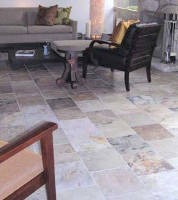
Slate Tile
How to:
Seal | Clean | Repair | Protect
Strip & Restore | Easy Care




Indian Slate (gauged) Indian Slate (ungauged)


Brazilian Slate Vermont Slate

Quartzite (see in "discussion" section below)
Traditional beauty with a great variety of colors, finishes, and shapes allow for a wide spectrum of rustic to sophisticated design options. Also used for wall cladding. For large commercial projects wall cladding that will be caulked, click here.
Further discussion about "Slate":
Slate is very dense and can sometimes be found mixed in pallets with the softer slate pieces. See the Quartzite page for more detail on this harder stone. Choose the sealer based on this less absorbent stone and let the more absorbent stones have more sealer. Some Indian and Chinese slates will flake and powder from foot traffic. This is not rust or other minerals coming to the surface. These are spots of softer material becoming loose particles. To see how to deal with this problem, click here.Some slates may be quite hard, but have a soft spot that can powder out. The powder residue is the same color as the slate. This is not efflorescence as that is a white powder. To prevent this gradual removal of slate that turns into a bigger and bigger hole, choose a sealer here that is classified as "strengthening".
Cement residue from grouting is difficult to clean from slates with ridges, crevices and holes. Do not use a sealer as a grout barrier (pre-seal). Prevent grout smears, surface scratching and keep grout residue out of surface texture by coating with Aldon "Grout Easy" before grouting. "Grout Easy" is a water soluble coating that comes off easily while grout is being cleaned up with water and a sponge.
Some Indian and Chinese slates will flake and powder from foot traffic. This is not rust or other minerals coming to the surface. These are spots of softer material becoming loose particles. To see how to deal with this problem, click here.
Some black and brown slates (if unsealed) can lose color from aggressive cleaning. Click here for color restoration.
Some slates have almost zero absorption and a surface that can darken in patches from cleaners, chemical action, and/or scrubbing action. This can be prevented by sealing with S-B-S Sealer.
Your Choices for Sealing
This surface is usually low absorption. Water base penetrating sealers have a difficult time penetrating down.
Our suggestions to test are:- Penetrating petroleum solvent formulas with acrylic solids. These can be sprayed to finish nicely, but solids level might need to be adjusted if manufacturer allows dilution.
- Water based film forming that can flow out and self-level.
- Click here to see What effects you can expect from each sealer type.
- Click here to see our suggested sealers, cleaners, and application tools.
Some questions you may not be thinking to ask right now that could become important:
. Was it sealed in the past? Does that matter?
. Will a new sealer be compatible with whatever was used before?
. What sealer will give the visual results you want?
. Will you also be able to have a sealer solve problem(s)? ( Answer: yes. Just know which to pick.)
Items of Interest
How to select a sealer
A sealer can do far more than just bead water and look pretty! To see what that is click here.
Important: If your project has had any sealer applied in the past, it must be evaluated differently. To see why, Click here!
Sealer "solids" levels?
A porous surface will require more gallons (more money) of a lower solids sealer than using a higher solids level sealer. That, plus different surfaces have different requirements. It is only a matter of which is best for your needs.
The more porous the surface, the more solids will be required to achieve the desired effects of gloss, strengthening, stopping efflorescence, etc.
The more porous the surface, generally the greater the need for the sealer to create a stronger surface.
An old sealer below the surface, even after stripping, will lower the absorption and porosity to some degree. Sometimes it is uneven below the surface and can create an uneven coloring effect with a color enhancing sealer applied later. Another reason to test first.
Do not believe yet that you have the type of surfacing you were told:
Colors fading?
Renew a glossy finish
Re: "penetrating sealers": do not apply thin layer upon thin layer. Apply a sufficient quantity to insure below surface penetration & bonding. A layer of sealer on top of another layer of sealer can result in poor bonding between layers and that can cause separation peeling that looks grayish.
Concerned about Doing It Yourself or what your contractor says?
If you are concerned about doing it yourself - consider that the satisfaction of a project is directly related to YOUR knowledge of what needs to be done and how. Who actually does the work is less important.
The goal for contractors is - NO CALL BACKS. A good contractor will understand the logic of not taking shortcuts.
©
The goal for contractors is - NO CALL BACKS. A good contractor will understand the logic of not taking shortcuts.